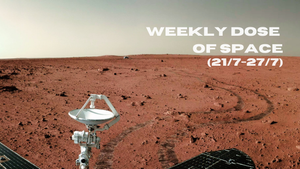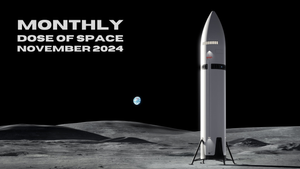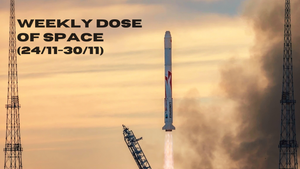
Weekly Dose of Space (21/7-27/7)
Welcome back to Weekly Dose of Space! This week once again had one orbital launch occur, this one however was a return to flight mission. News from this week had, Sierra Space burst a space station module, SpaceX win another launch contract, and a change in Dragon recovery operations. As always, we'll also look ahead to what the worldwide launch schedule might look like next week.
SpaceX
This week at Starbase began on July 21st when Ship 30 was rolled out from the production site to the Massey's test site ahead of a static fire in the coming days. Early the following morning, the fourth module of the second launch tower was moved next to the tower ahead of stacking.
July 25th saw the fourth tower module lifted onto the second launch tower, making the tower almost half of its potential height. The morning after the lift, the fifth tower module was rolled out and parked next to the second launch tower.
The 26th of July also saw Ship 30 perform a six-engine static fire at the Massey's test site. This was the second static fire for the ship following the replacement of its thermal protection tiles and engines.

Launches This Week
July 27th - Falcon 9 with Starlink Group 10-9
As part of a return to flight mission, SpaceX launched twenty-three Starlink satellites to low Earth orbit from Launch Complex 39A, in Florida. The booster supporting this mission was B1069 making its seventeenth flight and successfully landing on the drone ship 'Just Read The Instructions' downrange.

In Other Space News
Dragon recovery moving to U.S. West Coast

SpaceX announced on July 26th that future Crew and Cargo Dragon missions will splashdown off of the west coast of the United States, beginning in 2025. This switch was prompted by debris from the Dragon spacecraft's trunk falling back to Earth.
SpaceX discovered back in 2022 that the materials from Dragon's trunk could survive atmospheric reentry after part of it was discovered in Australia. Discovery of parts of Dragon trunks continued intermittently into 2024.
Dragon's trunks are left in low Earth orbit prior to a de-orbit burn, this is believed to lower the risk to crew during return to Earth. Once the Dragon trunk is left in orbit it will slowly decay due to drag and ideally burn up, but with no control over where.
To mitigate this, SpaceX is switching to recovering Dragon spacecraft on the West Coast along with separating the trunk after performing a de-orbit burn. Both of these are thought to increase public safety as the trunk is burning up over the Pacific Ocean, and if any parts survive they will fall into a sparsely populated area of the ocean.
SpaceX wins JPSS-4 launch contract

NASA announced on July 22nd that it had selected SpaceX to launch the U.S. National Oceanic and Atmospheric Administration's JPSS-4 satellite. JPSS-4, or Joint Polar Satellite System 4, is part of a small group of satellites collecting global multi-spectral radiometry and other specialized meteorologic, oceanographic, and solar-geophysical data via remote sensing of land, sea, and atmospheric properties.
The contract is a firm fixed price with SpaceX receiving approximately 112.7 million United States for a single Falcon 9 launch from Space Launch Complex 4E, in California. Currently the launch of JPSS-4 is expected to occur in 2027.
Sierra Space bursts module for science

On July 25th Sierra Space revealed that it had successfully conducted its second 'Ultimate Burst Pressure' test on June 18th. The test had Sierra Space's inflatable module reach a pressure of 74 psi, surpassing NASA's recommended safety level of 60.8 psi by twenty-two percent, with a believed internal volume of 300 meters cubed. Speaking in the press release about the test, Tom Vice, Chief Executive Officer of Sierra Space, said the following:
“Our revolutionary, expandable space station technology reinvents the space station. Our technology, for the first time, will enable the right unit economics that will usher in the full commercialization of space. Our biotech and industrial partners will utilize our factories of the future to innovate new products that will massively disrupt terrestrial markets and benefit life on Earth.”
This was the second major burst test performed on a test inflatable module by the company, the previous test reached a pressure of 77 psi. With two successful tests, with results within five percent of each other, Sierra Space believes they can speed up the flight certification process for its modules.
What to Expect Next Week
Starbase
SpaceX is still awaiting regulatory approvals for changes in its flight plan for the fifth test flight, due to this a launch is now expected to occur in August. Regulatory approval for the flight is needed due to a potential landing of Booster 12 back at the launch site, on the launch towers 'chopsticks'.
With static fires completed on both flight vehicles, Booster 12 and Ship 30, the final major hardware milestone is still believed to be a wet dress rehearsal involving both vehicles on the launch pad.
July 28th - Falcon 9 with Starlink Group 10-4
Another batch of Starlink satellites are expected to head to low Earth orbit atop of Falcon 9, this time from Space Launch Complex 40 in Florida. The booster for this mission is currently unknown but it is expected to land downrange on a drone ship.
July 28th - Falcon 9 with Starlink Group 9-4
Yet more Starlink satellites are expected to be sent into low Earth orbit aboard Falcon 9, this launch will occur from Space Launch Complex 4E. This mission's booster is also unknown but it is expected to land on the drone ship 'Of Course I Still Love You' downrange.
July 30th - Atlas V for USSF-51
A United Launch Alliance Atlas V is expected to launch the USSF-51 mission from Space Launch Complex 41, in Florida. The payload is unknown to the public due to its classified military uses.
July 30th - Electron for 'Owl for One, One for Owl'
Rocket Lab is planning to launch its Electron rocket to a sun-synchronous orbit carrying a synthetic aperture radar satellite. The satellite will be operated by Synspective once on orbit.
July? - Ceres-1S with a to-be-announced payload
Galactic Energy may launch a Ceres-1S from a sea launch platform, the company has also not yet announced what payloads will be onboard.
August 3rd - Falcon 9 with Cygnus NG-21
SpaceX is expected to launch the twentieth Cygnus resupply mission to the International Space Station from Space Launch Complex atop of Falcon 9. Cygnus is expected to bring science experiments, equipment, and consumables to the crew aboard the station.




